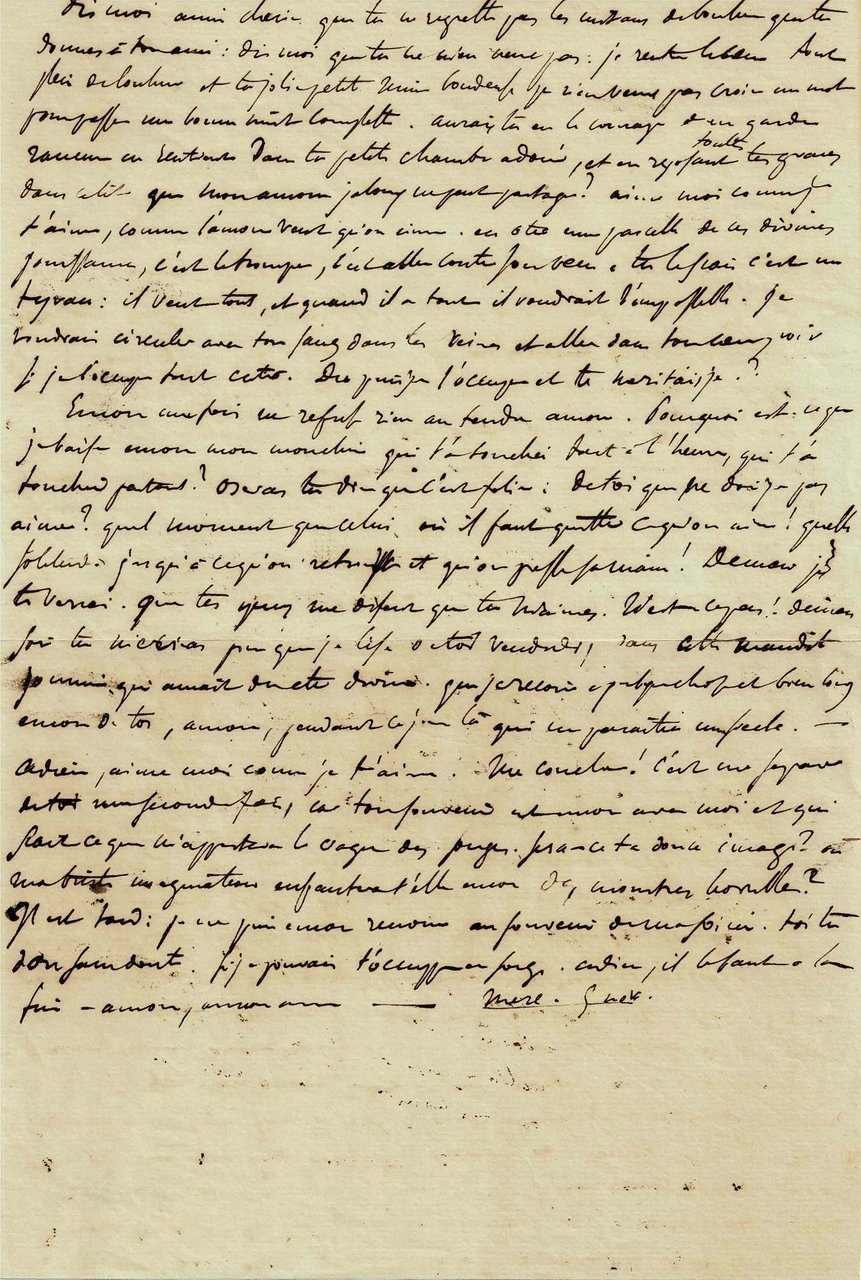- mercredi 5 novembre [1823], 19,7x29,9cm, une feuille rempliée. - Handwritten letter to "Julie" (Louise de Pron): "I would like to circulate with your blood in my veins and go into your heart, to see if I occupy it entirely" Wednesday 5 November [1823] | 19,7 x 29,9 cm | one double leaf Handwritten dated letter from the painter Eugène Delacroix to the love of his youth, the mysterious "Julie", now identified as being Madame de Pron, by her maiden name Louise du Bois des Cours de La Maisonfort, wife of Louis-Jules Baron Rossignol de Pron and daughter of the Marquis de La Maisonfort, Minister of France in Tuscany, patron of Lamartine and friend of Chateaubriand. 27 lines on a folded leaf. Two marginal tears on the fold of the leaf. Discreet tears to the upper part. Note in pencil from a previous bibliographer on the upper right (« No 11 »). This letter remains one of the last to his lover in private ownership, all of Delacroix's correspondence to Madame de Pron being kept at the J. Paul Getty Research Institute (Los Angeles). It was only transcribed in the Burlington Magazine in September 2009, alongside the long article by Michèle Hanoosh, Bertrand and Lorraine Servois, whose research finally revealed the identity of the famous recipient. "Love me like I love you, as love wants us to love." Writing in the heat of passion, the young Eugène gave free rein to his amorous form in this true epistolary work of art, where desires and memories, romanticism and prosaicness combine, and from which the great pictorial themes of the genius Delacroix emerge. In April 1822, when he presented his first large painting Dante et Virgile aux Enfers, at the Salon, Delacroix discovered Paradise thanks to his meeting with Madame de Pron, mistress of his close friend Charles Soulier who asked him to paint the portrait of her son, Adrien. No one knows if this portrait that has never been found was ever completed, but it served as a pretext for the secret meetings of the two lovers in the studio on rue de Grès. Louise's beauty had been immortalized a few years earlier by the delicate stroke of Élisabeth Vigée-Lebrun, who painted a portrait of her with an oriental hairstyle in a naturally elegant pose. Their adventure lasted a little over a year, but it was one of the most intense passions of the artist's life. He was not, however, the only lover of this astonishing woman, whose alcoholic and violent husband had just been interned at the Royal House of Charenton after being declared insane. Alone, Madame de Pron found comfort in the arms of a group of lovers, including Soulier, a friend of Delacroix, and General de Coëtlosquet, whom she would marry after her divorce was finalized in 1829. These scandalous affairs could, under no pretext, been made public; and Delacroix, in his letters and notebooks, therefore nicknamed his lover "Julie" (in reference to La Nouvelle Héloïse), "J." or "Cara". His discretion was such that even his biographers could not until recently discover the mysterious identity of Delacroix's most burning passion. The future painter of harems from Algiers was himself, therefore, one of Madame de Pron's men. Although he respects his rivals, one of whom is a close friend and the other a future sponsor for whom he will later paint his surprising Nature morte au homard, (Louvre Museum), Delacroix suffers from the polyandry of his mistress, while he himself abandoned Émilie Robert, his lover and model for Scènes du Massacre de Scio. Delacroix's letters bear the mark of "Julie"'s painful inconsistency, and of the precariousness of this mad love for an aristocrat of high lineage, married, mother, twelve years his senior and already promised to her noble and rich cousin. But that is of little importance because "Love [.] is a tyrant: it wants everything, and when it has everything, it wants the impossible." The beauty of the lovers' love letters shares the same perfection of the painter's works; Delacroix multiplies his sketch

Find out how to use
Find out how to use
